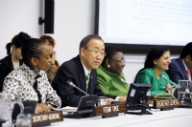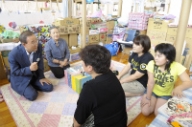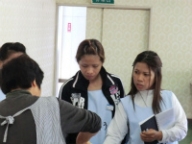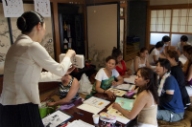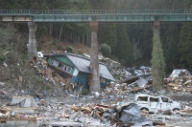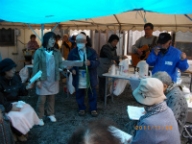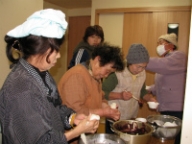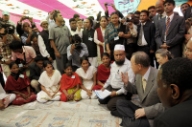Women in Tohoku, One Year On -- In Commemoration of International Women’s Day 2012
2012.03.15
In commemoration of the International Women’s Day (8 March), the United Nations Information Centre in Japan focused on the “Women in Tohoku, One Year On”. The rural areas of Tohoku region encompass three prefectures hit most by the earthquake and tsunami of 11 March 2011 and the ensuing nuclear accidents: Iwate, Miyagi and Fukushima prefectures.
UNIC Tokyo met with many people who have been directly affected by this tragedy, as well as those who have been working with the people in support of their efforts to recover and rebuild. Among the many human stories coming out of affected areas, the story of one woman, a mother of three, who evacuated out of the restricted area in Fukushima Prefecture, highlights the plight for physical safety and economic stability. The concern for safety from radiation is paramount for the people in Fukushima, especially for parents of younger children. As a single mother, she was able to make the decision on her own to leave her hometown and start a new life elsewhere, even though prospects for a job and a permanent new residence remain “a blank”, according to her. “I know many other moms from the area who have left with their children, but they are under pressure from their husbands to return. Some have no choice.”
Economic stability, as well as a desire to become a professional care giver is what led Christina Konno (from Kesennuma, Miyagi Prefecture) and Christine Sasaki (from Rikuzentakata, Iwate Prefecture) to subscribe to a course to qualify as a care giver for the elderly. The language support provided by a non-governmental organization was critical in helping Christina and Christine through the rigorous course. Both had come to Japan some years ago and married Japanese men but had never gained the confidence to apply for a professional qualification. After surviving the earthquake and tsunami but having lost their previous jobs, both had started to look for employment opportunities. It did not take long for Christina and Christine to discover the constant and high demand for care givers for the elderly in Tohoku, where there had been a chronic shortage of qualified care givers even before the disaster of March 11. “Of course the experience of the earthquake was devastating. But the fact that I have become a qualified care provider has been the most life changing experience in my entire life,” says newly empowered Christina who has already inspired and helped other women in the affected area to challenge their own potential.
Yoko Tanaka, Director of the Tohoku Reconstruction Head Office of the Workers Cooperative, describes another reality faced by women in a post-disaster situation: as mothers and wives, women often focus on the well-being of their children and husbands first, leaving little room and energy to look outwards, or seek employment. It was only in early January 2012, 10 months after the disaster, that the Workers Coop initiatives to create jobs and provide skills training were met with interest and enthusiasm by the local communities in the affected areas.
One particularly successful case was a joint effort with members of the local community of Kesennuma City, which had mobilized to build a local shopping mall near the temporary housing areas, designed to accommodate 52 businesses, including some space dedicated for community use. After discussing at great length with the local leaders and people involved in the projects, Yoko was able to persuade them to use part of the space for job-training classes. This led to a record-high registration for the training course which will run for four months, with a large number of women participants. Yoko has also facilitated the start-up of a Tofu business in Ofunato (Iwate Prefecture) which will start in April, with support from Tofu makers from Saitama Prefecture who had spent some time sharing their know-how for a successful local business. “Our motto is job creation and self-help,” says Yoko, who has spent her entire career with the Workers Coop. “The local people in the affected areas are the drivers for creating work. We will support them in these efforts – that is how the affected area can revive.” “Women and young people who previously hesitated to step out and engage, are looking at life in a completely different way since the earthquake, thinking about the needs of the community. They are asking themselves what they can do to be useful,” says Yoko of the people she has interacted with in the past year. Among the women, many are discovering the empowering effect of working in cooperation with others. Through joint efforts, they have come to realize that their talent will be an important input for the rebuilding of their communities.
Professor Masako Tanaka (Bunkyo Gakuin University) who is also an Executive Member of the newly established Rise Together for Women in East Japan Disaster, a lobbying group advocating for the inclusion of gender perspectives and diversity in Japan’s reconstruction plans, points to the lack of gender sensitivity in the post-disaster recovery and reconstruction efforts. While other countries prone to natural disasters have incorporated gender perspectives in their national disaster reduction strategies, it was not uncommon to hear that “there was no need for special attention for women in an advanced country like Japan.” Job creation and employment being an ongoing challenge in the Tohoku region, it was noted that men were paid daily wages for their work removing debris throughout the region, while the work of women providing meals three times a day to the workers or evacuees was considered volunteer work that needed not be paid. Some women in Minamisanriku cho (Miyagi Prefecture) for example, themselves thought of their work as an extension of their house work and hesitated to consider their time spent worth of monetary compensation.
Professor says that in order to adequately reflect gender and diversity in the reconstruction phase, it was important that local associations including local women’s organizations and non-governmental organizations engage directly with central and local government officials from planning to implementation. The support of professional experts who can represent and coordinate gender and diversity perspectives is essential for post-disaster reconstruction. Japan can draw clues from international lessons learned in gender-sensitive approaches to recovery and reconstruction, says Professor Tanaka.
For all the women we covered in this story, the recovery of a safe environment and economic stability was of paramount concern. The International Labour Organization (ILO) emphasizes that placing an effective employment strategy at the heart of reconstruction planning will empower the people in the affected area to truly rebuild on their own. For that, actual local needs have to be properly analyzed and addressed – residents of the affected area themselves need to participate directly in the formation of the reconstruction plan. Not only should the voices of the local leaders be reflected but also the perspective of women, the youth, the elderly, people with disabilities and others must be included. Shukuko Koyama, Crisis Specialist at ILO emphasized also that it was important to identify business chances for women in the affected areas even though, at first glance, it may not seem obvious in the aftermath of such great disasters. Just like the women in Ofunato, who are starting a tofu business, there are many opportunities for new business in a post-disaster area, with minimum technical support as well as some start-up funds. Women in other parts of the country who have successfully started business could also help by sharing their experience with the women in the affected areas. Shukuko, whose mother is from Minamisoma city, one of the worst-hit places, emphasized “people in the affected areas are not ‘unfortunate victims’ but rather talented human resources. The potential of these human resources must be fully uncovered. Only when they are put to full use will true reconstruction become a reality”.
* * * * *
